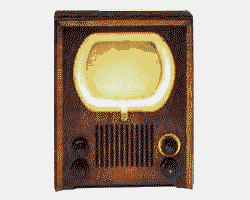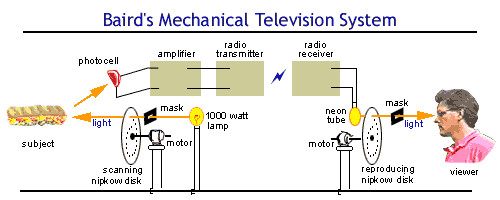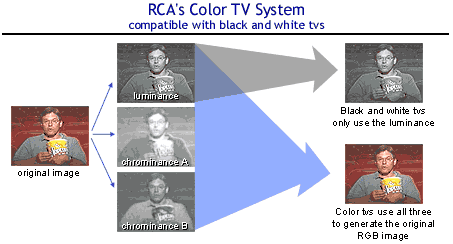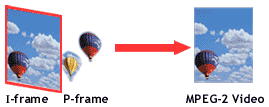

The history of television is short, but compared to the telephone and the computer, it hasn't kept up with the advance of technology. HDTV development has spanned nearly 30 years, yet it is still a measure away from being a household item. In this review to give you some fundamental reasons why HDTV is certain to be a valuable asset to your quality consciousness and to illustrate those things which still inhibit it.

It all goes back to a little invention by Paul Nipkow in 1884 consisting of a disk with holes spiraling inward. I know it's hard to believe, but this little disk shaped the development of television. Engineers like John Logie Baird and Charles Francis Jenkins, among others, used Nipkow's disk to create the first systems for scanning, transmitting, and receiving images in the 1920's. These guys created entire television systems based on mechanical image scanning and receiving. No Cathode Ray Tubes (CRTs) here.

Electronic
television systems lagged behind mechanical systems for several years,
mostly because mechanical television was cheaper to build and it didn't
use delicate parts. Not only that, but it was really hard to get financial
backing to develop electronic TV when mechanical TV worked so much better
at the time. It wasn't until Vladimir Kosmo Zworykin and Philo T. Farnsworth
started their work that electronic television began to catch up. With a
cheaper system that already worked, few people saw the need to change.
Vladimir
Zworykin, one of the few, got help from David Sarnoff, Senior Vice President
of RCA, David Sarnoff. Sarnoff had been paying attention to mechanical
television development and predicted that electronic TV would eventually
be more commercially viable. Another engineer, Philo Farnsworth, also found
some investors to back his ideas, and he was off to the races with Vladimir.
Electronic TV
Both Farnsworth
and Zworykin, working separately, and each made great advances towards
the goal of commercial television and affordable TV sets. By 1935, both
were broadcasting intermittently, using all electronic systems. But Baird
Television had been broadcasting since 1928 with an all mechanical television
system. At the time, very few people had television sets, and the ones
they had were poor quality. I mean, we're talking screens 2 or 3 inches
wide. The competition was hardly noticed, but it was there. The eventual
winner would need to have their method accepted as the standard.
![]()
By 1939, RCA
and Zworykin were ready for regular programming and they kicked it all
off by televising the World's Fair in New York. Things moved quickly, and
in 1941 the National Television Standards Committee (NTSC) decided it was
time to write guidelines for television transmission in the United States.
Five months later, all 22 of the nation's television stations converted
to the new electronic standards.
In the early
years, during the Great Depression, television sets were too expensive.
When prices eventually dropped, the U.S. was knee-deep in World War Two.
But when a new age dawned after the war, it was the Golden Age of Television.
Unfortunately, everyone had to watch it on black and white.
Color TV

CBS developed a workable color system years before their rival, RCA, but it was incompatible with the huge number of black and white sets in homes throughout the country. CBS poured a lot of money into their new color system, but it was all for nothing. RCA, motivated by CBS's work on a color system, bet on their own color system. They soon had a color system that would work on monochrome monitors too. After RCA demonstrated their system, the NTSC adopted it for commercial broadcasting in 1953.
Over forty years later, we now talk to each other on digital cellular phones and send email over a global network, but television in the United States has stayed essential the same. Sure, we've seen a few incremental advances, such as stereo sound, closed captioning, and better color, but nothing has come along to shake up the way we think about television. But that's about to change. Television is going digital.
Going Digital!
What makes digital television so special? A digital image isn't inherently better than an analog image, and in some cases it can be worse. An HDTV picture doesn't have to be digital either; Japanese HDTV is broadcast over an analog signal. There has to be another reason why the United States is choosing to go through the pain of switching from analog to digital.

In fact, there are several good reasons to go digital, including: how much data it can transmit, how consistent the data stays over distance, and what type of data the signal can carry. For the same amount of bandwidth, you can stuff a lot more information into a digital signal than an analog signal. A digital signal doesn't produce the same problems with the picture we see on a distant analog television, either. And television in the digital age won't be limited to video and audio; our televisions will become truly interactive. Combined with HDTV and digital sound, this means a better picture, better sound, and digital data. But how are we going to fit all this into the same amount of frequency?
Bandwidth Squeeze
Unlike many other countries, the United States is converting to both digital signals and high-definition pictures at the same time. Some countries are already broadcasting high-definition pictures, but they're using an analog signal. To send more picture detail, they just expanded the amount of frequency bandwidth for each. Broadcasters in the United States won't have the option to expand the size of their signal. They'll have to squeeze more picture detail into the same bandwidth they were using for analog television.

MPEG-2
 Video
on digital TV will be compressed using a scheme called MPEG-2.
It takes advantage of how the eye perceives color variations and motion.
Inside each frame, an MPEG-2 encoder records just enough detail to make
it look like nothing is missing. The encoder also compares adjacent frames
and only records the sections of the picture that have moved or changed.
If only a small section of the picture changes, the MPEG-2 encoder only
changes that area and leaves the rest of the picture unchanged. On the
next frame in the video, only that section of the picture is changed.
MPEG-2 has some problems, but it's a good compression scheme and it's already
an industry standard for digital video for DVD-Videos and some satellite
television services. One problem with MPEG-2 is that it's a "lossy" compression
method. That means that a higher
compression rate gives a poorer picture. There's some loss in picture
quality between the digital video camera and what you'll see on your television.
However, the quality is still a lot better than an average NTSC image.
And using these compression schemes, MPEG-2 can reduce the amount of bits
by about 55 to 1! With that ratio, there's a lot of information that
get's thrown away, but there's still enough to look like everything is
still there. The human ear isn't as easy to fool, though. It's much more
sensitive to subtle changes in sound. Digital TV is going to improve the
sound too using advances in digital sound developed since the 1970's.
Video
on digital TV will be compressed using a scheme called MPEG-2.
It takes advantage of how the eye perceives color variations and motion.
Inside each frame, an MPEG-2 encoder records just enough detail to make
it look like nothing is missing. The encoder also compares adjacent frames
and only records the sections of the picture that have moved or changed.
If only a small section of the picture changes, the MPEG-2 encoder only
changes that area and leaves the rest of the picture unchanged. On the
next frame in the video, only that section of the picture is changed.
MPEG-2 has some problems, but it's a good compression scheme and it's already
an industry standard for digital video for DVD-Videos and some satellite
television services. One problem with MPEG-2 is that it's a "lossy" compression
method. That means that a higher
compression rate gives a poorer picture. There's some loss in picture
quality between the digital video camera and what you'll see on your television.
However, the quality is still a lot better than an average NTSC image.
And using these compression schemes, MPEG-2 can reduce the amount of bits
by about 55 to 1! With that ratio, there's a lot of information that
get's thrown away, but there's still enough to look like everything is
still there. The human ear isn't as easy to fool, though. It's much more
sensitive to subtle changes in sound. Digital TV is going to improve the
sound too using advances in digital sound developed since the 1970's.
NHK (Japanese Broadcasting Network) began work on the future of broadcasting in 1964, the same year the Olympics were held Japan. The reasons for doing so have long since become folklore. Some say NHK simply wanted to increase the enjoyment for the viewers. Others point out that NHK knew the day of their monopoly status would end with deregulation and that every edge, including technical quality, had to be used for competitive reasons. Still, another view has it that a new world production standard was needed and Japan would particularly benefit from access to world program connections. Some sterner critics see a sinister side where Japan would focus all its resources to creating a new television era with the strategy of leaping ahead of everyone else and staying ahead so as to finally dominate global communications. All others would have to compete to maintain their self-respect and Japan would sell the rest of the world the production and consumer HDTV equipment to do so.
Some grounds for believing such a strategy existed with certain agencies surfaced in the 80s. But international domination of any sort would have proved to be Japan's worst nightmare, rather than a dream. Japan does not have enough international goodwill to carry such heavy political responsibilities.
Still, after the first transmission of HDTV in Japan in the early 1980s using their MUSE decoding scheme the American Electronics Association said HDTV will be the most powerful driver of advanced electronics in the world. If Japan had a dominant role in its manufacturing it could hold true that they might dominate other fields. Uncle Sam worried about defense and the Bush administration told the FCC to get America in the lead, or else. But I am ahead of myself. The purpose of this article is to give you a fundamental understanding of why there have been billions of dollars spent on HDTV and why, after all of this talk, you still can't buy one in your favorite outlet.
![]()
 Next
Next